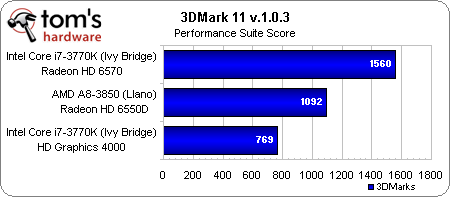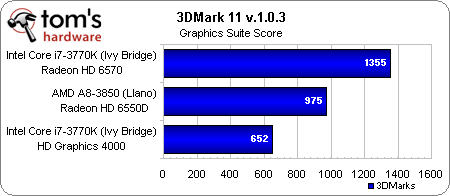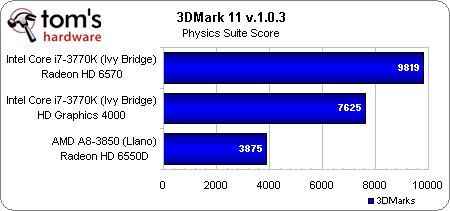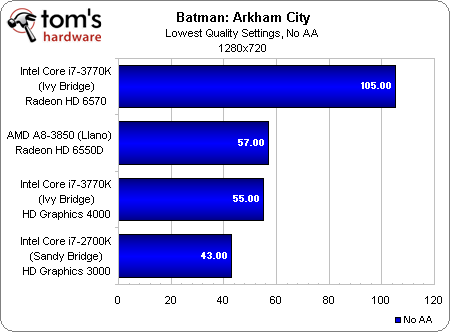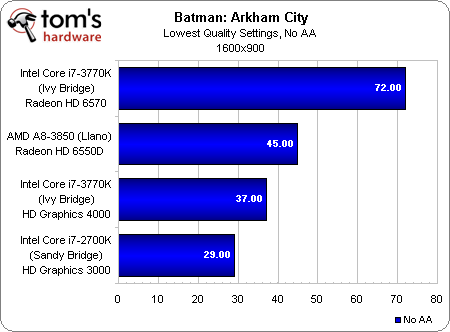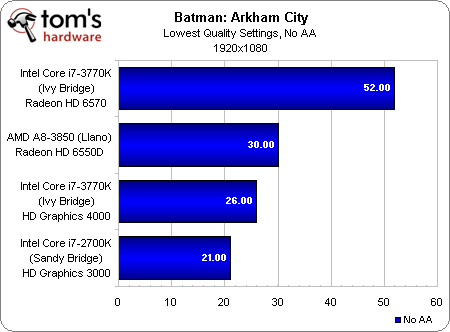Intel Core i7-3770K Review: A Small Step Up For Ivy Bridge
HD Graphics 4000: Performance In 3DMark 11 And Batman
Because 3DMark 11 requires DirectX 11 support, Sandy Bridge-based CPUs can’t run it. That leaves us with the Core i7-3770K, AMD’s A8-3850, and a discrete Radeon HD 6570.
Despite Intel’s efforts to double graphics performance, the Core i7-3770K cannot outmaneuver AMD’s Llano-based A8-3850.
Here’s the funny thing: every time Intel advances its on-board graphics technology, I talk to industry insiders who worry that the processor company’s progress will completely kill off the entry-level discrete market. But a Radeon HD 6570, available for under $60, still manages to double Ivy Bridge’s best effort. At least on the desktop, even inexpensive add-in boards still have their place.
The Physics suite, which measures processor performance, is particularly interesting. Tons of testing over the past year tells us that Intel’s Sandy Bridge cores get a lot more work done per clock cycle than AMD’s. Llano’s mediocre performance consequently isn’t news. However, the fact that Core i7-3770K picks up more than 2000 points with a discrete GPU installed is a good indication that the integrated core’s thermal requirements limit what the IA cores can do.
In a real-world game like Batman: Arkham City, HD Graphics 4000 nearly does manage to catch AMD’s A8-3850. But generating playable average frame rates requires the title’s lowest possible detail settings and fairly unattractive resolutions. In contrast, even a cheap Radeon HD 6570 can handle entry-level detail at up to 1920x1080.
Get Tom's Hardware's best news and in-depth reviews, straight to your inbox.
Current page: HD Graphics 4000: Performance In 3DMark 11 And Batman
Prev Page HD Graphics 4000: The Plus In Intel’s Tick+ Next Page HD Graphics 4000: Performance In Skyrim And WoW-
tecmo34 Nice Review Chris...Reply
Looking forward to the further information coming out this week on Ivy Bridge, as I was initially planning on buying Ivy Bridge, but now I might turn to Sandy Bridge-E -
jaquith Great and long waited review - Thanks Chris!Reply
Temps as expected are high on the IB, but better than early ES which is very good.
Those with their SB or SB-E (K/X) should be feeling good about now ;) -
xtremexx saw this just pop up on google, posted 1 min ago, anyway im probably going to update i have a core i3 2100 so this is pretty good.Reply -
ojas it's heeearrree!!!!! lol i though intel wan't launching it, been scouring the web for an hour for some mention.Reply
Now, time to read the review. :D -
zanny It gets higher temps at lower frequencies? What the hell did Intel break?Reply
I really wish they would introduce a gaming platform between their stupidly overpriced x79esque server platform and the integrated graphics chips they are pushing mainstream. 50% more transistors should be 30% or so more performance or a much smaller chip, but gamers get nothing out of Ivy Bridge. -
JAYDEEJOHN It makes sense Intel is making this its quickest ramp ever, as they see ARM on the horizon in today's changing market.Reply
They're using their process to get to places they'll need to get to in the future -
verbalizer OK after reading most of the review and definitely studying the charts;Reply
I have a few things on my mind.
1.) AMD - C'mon and get it together, you need to do better...2.) imagine if Intel made an i7-2660K or something like the i5-2550K they have now.
3.) SB-E is not for gaming (too highly priced...) compared to i7 or i5 Sandy Bridge
4.) Ivy Bridge runs hot.......
5.) IB average 3.7% faster than i7 SB and only 16% over i5 SB = not worth it
6.) AMD - C'mon and get it together, you need to do better...
(moderator edit..) -
Pezcore27 Good review.Reply
To me it shows 2 main things. 1) that Ivy didn't improve on Sandy Bridge as much as Intel was hoping it would, and 2) just how far behind AMD actually is... -
tmk221 It's a shame that this chip is marginally faster than 2700k. I guess it's all AMD fault. there is simply no pressure on Intel. Otherwise they would already moved to 8, 6, and 4 cores processors. Especially now when they have 4 cores under 77W.Reply
Yea yea I know most apps won't use 8 cores, but that's only because there was no 8 cores processors in past, not the other way around
